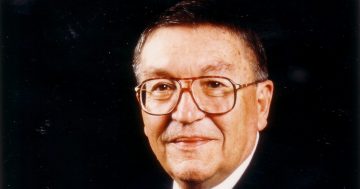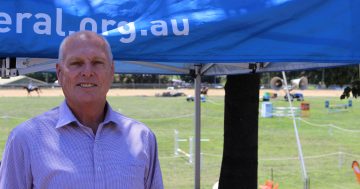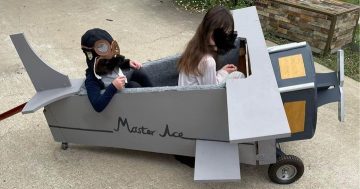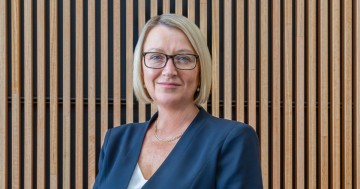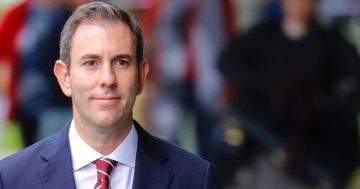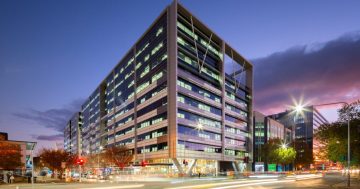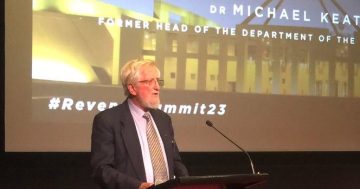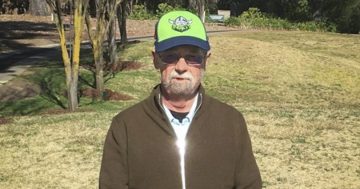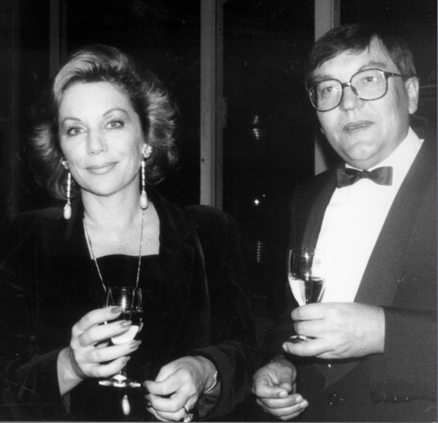
Ita Buttrose and Jim Service at the Canberra launch of an appeal for funds for the ANU. Photo: ACT Heritage Library Administration Collection.
For 57 years, James (“Jim”) Glen Service – banker, property expert and company director – was identified with most things commercial and cultural that happened in the national capital.
Those who knew “Mr Canberra” found him a tough-minded businessman, conscientious about “giving back”, with a wonderful sense of the absurd.
Born on 9 February 1933, son of William Arthur and Lesley Mary Service, young Jimmy spent his first four years in Fiji where his father worked for Colonial Sugar Refineries as a buyer of jute.
Though educated at Newington College (1945-49), excelling in his studies, winning a string of academic prizes, Jim was as he said: “… a wild teenager, and I loved the physical life.”
He worked for two years as a jackaroo at Monwonga Station, a sheep property west of Forbes in NSW, before returning to Sydney, at first at Prouds jewellery. He studied accountancy at night.
On 10 September 1955, he married Dorothy Kenny and they raised three sons and a daughter, all of whom worked at different times in the family property business.
His business career followed a steady trajectory: In 1959 he became head accountant at CAGA finance company; in 1963, an executive director of the listed Canberra-based accommodation and restaurant group, Moteliers Ltd.
In 1964, Jim and Dorothy moved their young family to Canberra. He rose to Motelier’s chief executive, but later quit when the company was acquired by the ill-fated Mainline building group.
Jim’s impact on Canberra was the result of his relentless determination in building, funding, and imagining a modern, lively metropolis; he learnt from others, and aspired to assist fledgling organisations in the cultural and administrative life of his adopted city.
In 1969 he formed a property consultancy and construction company with builder Len Goodwin and pharmacy owner Arthur Kenyon. They developed shopping centres in Canberra, starting with Kippax Fair and Jamieson Centre, then branched out to property project management advisory across Australia and as far as Fiji and Papua New Guinea.
Jim formed his own business, JG Service Pty Ltd, itself becoming a global property advisory and project management business.
He quipped: “I have a low boredom threshold. That’s why I take on things…”
Both Kenyon and Service were involved in the embryonic Canberra building society movement, which became a major force in Canberra’s economy. Jim was deputy chair, and then Chairman of the Civic Permanent Building Society from 1984 until it was absorbed by the Civic Advance Bank in 1986, which in turn absorbed the Canberra Building Society of which Kenyon was chair, 1964-90. Jim became Chair of Advance Bank, 1992-97, thereby becoming the first Canberra businessman to head a major Australian public company.
At the helm of ACTEW from 1995-2008, then the energy JV, ActewAGL, 2000-08, he picked the two exceptional CEOs of Canberra in modern times – John Mackay and Michael Costello, with the latter succeeding the former as CEO of ACTEW then of ActewAGL.
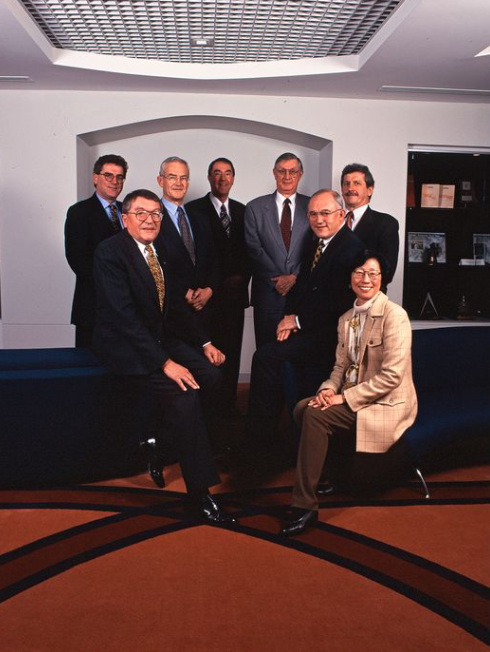
Jim Service (Chair) and the ACTEW Board in 1998, including John Mackay (CEO). Photo: Supplied.
In Who’s Who, Jim listed his recreations as travel and art. Examples of his extensive patronage included Canberra Floriade and the Bundanon Trust.
Jim served as Chairman of the National Museum of Australia (1996-99), Chairman of the Canberra Theatre Trust (1993-95), and Chairman of the National Gallery of Australia Foundation (1994-96).
There were so many boards he participated in, patiently shaping, and providing leadership to an interesting city in-the-making: Canberra.
He was long-time Chairman of the Salvation Army Advisory Board, patron of the Spirit of Calvary Hospital capital development campaign and supported many major charity fund-raising campaigns in Canberra.
In 1992, he observed: “They talk about Canberra being cocooned, but people in the public service and in the private sector here travel a lot. They meet people all over Australia. They are the least cocooned people in Australia. People in Sydney and Melbourne sit in their offices and think it is the centre of the universe.”
Jim foresaw the private sector and diversification potential and argued Canberra needed to vigorously market its well-educated population, its premier research university-presence, other centres of knowledge-based industries, cheaper processing costs for high-tech industries, and open spaces.
In 2001 he was named Canberran of the Year by the ACT Government.
Arguably the development of offices, technology businesses around Canberra airport, which Jim imagined in consultation with Jim Snow, is one of his premier legacies.
His leadership of the property sector extended to the national presidency of the Building Owners and Managers Association (BOMA), and its successor body, the Property Council of Australia; inaugural Chairman of the Australian Building Codes Board; and Chair of the builder, Barclay Mowlem & Co. He also served terms on the boards of Challenger, Australand, and CapitaLand (Singapore).
On building standards and revised codes, Jim commented: “We have to get it right. We can’t play ducks and drakes with people’s safety.”
But he thought about changes introduced in the mid-1990s: “If there were an Olympics for building, this new code would be our chance to win a gold medal. The scope to propagate modern Australian design systems in Asia is huge. Many countries there are concerned about their fire standards and very willing to study an Australian model.”
Jim once mentioned he sketched a speech to deliver in Australia while sitting in a garden at a Malaysian resort. When he turned his back, a monkey relieved itself on the notes. He remarked that Australian politicians treat property developers with similar undeserved disdain. He commented: “My biggest task at BOMA is to convince politicians that property investment is not some kind of speculation, but a great generator of offices, factories and shops for the community.”
Jim received numerous awards including Member of the Order of Australia (AM) in 1990 for service to the community, the 2001 Centenary Medal for service in developing Australia’s construction industry, and in 2004, Officer in the Order of Australia (AO) for service to business and to the community, particularly through support for arts, cultural and charitable organisations.
In 2012, already an Adjunct Professor of the National Institute of Governance at the University of Canberra, Jim was awarded an honorary doctorate.
He and Dorothy, his wife of 66 years, enjoyed ribbing each other in case either one got too serious. Theirs was a joyous dynamic.
Jim Service is survived by Dorothy, their children James, Catherine, Adrian, and Robert, their partners, and seven grandchildren, and a brother David.
Due to COVID restrictions, the service at the chapel of Norwood Park Crematorium at noon on Wednesday, 13 October, is private but live-streamed here.
Written by Dr Michael Easson AM, who over 20 years served on the Boards of ACTEW, ActewAGL, Barclay Mowlem, and the EG Perth Rail Link Trust with Jim Service.











